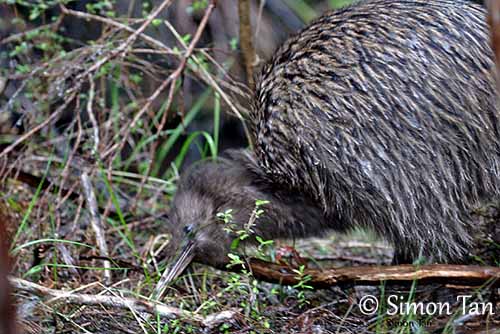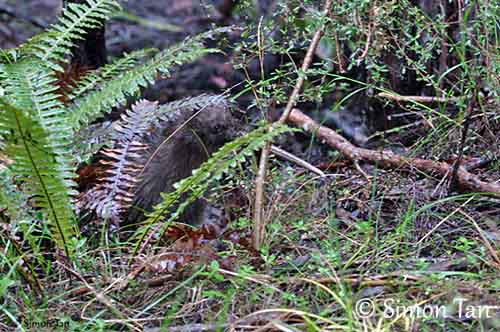
Fr: Kiwi austral
Ang: Southern Brown Kiwi
Maori: Tokoeka
All: Streifenkiwi
Esp: Kiwi Común
Ita: Kiwi bruno
Nd: Zuidelijke Bruine Kiwi
Sd: Rothschilds kivi
Photographer:
Simon Tan
PBase Bird galleries
Text by Nicole Bouglouan
Sources:
HANDBOOK OF THE BIRDS OF THE WORLD vol 1 by Josep del Hoyo-Andrew Elliot-Jordi Sargatal - Lynx Edicions - ISBN: 8487334105
KNOW YOUR NEW ZEALAND BIRDS by Lynnette Moon - New Holland Publishers – ISBN: 1869660897
L’ENCYCLOPEDIE MONDIALE DES OISEAUX - Dr Christopher M. Perrins - BORDAS - ISBN: 2040185607
BirdLife International (BirdLife International)
New Zealand bird status between 2008 and 2012
Wikipedia, the free encyclopaedia
Animal Diversity Web (University of Michigan Museum of Zoology)
Southern Brown Kiwi
Apteryx australis
Apterygiformes Order – Apterygidae Family
INTRODUCTION:
The Southern Brown Kiwi is the only one visible by day on Stewart Island, usually on cloudy days or at dusk, because it has poor vision and small eyes. It can only see 50-60 cm in front of them in daylight, and about 150-180 cm by night.
This bird shows several unique features, among them, vestiges of wings, bill with nostrils at the tip, small eyes, peculiar plumage and pear-shaped body.
It is flightless, but it walks and runs easily.
The subspecies Apteryx australis lawryi from Stewart Island, New Zealand, is displayed on this page.
DESCRIPTION OF THE BIRD:
Biometrics:
Length: 45 cm
Weight: M: 1440-3060 g – Bill length: 11-15,5 cm
Weight: F: 2060-3850 g – Bill length: 13-20,5 cm
The adults have hair-like plumage.
The upperparts are dark reddish-brown with black streaks.
The underparts are mostly grey to grey-brown.
Head and neck are dark grey with slightly paler face. We can see some long rictal bristles around the base of the bill. These feathers have tactile function.
The bill is whitish to pinkish-horn. The nostrils are situated at the tip of the bill. The small eyes are dark brown. Short, thick legs and strong feet are pinkish or brown.
The Southern Brown Kiwi has rotund silhouette and lacks a visible tail. The wings are only vestiges hidden within the thick plumage.
The female has similar plumage but she is larger than male and her bill is longer.
The juvenile resembles adult but it is smaller. It has softer plumage, more downy appearance, but the downy stage does not exist in this family.

SUBSPECIES AND RANGE:
A.a. australis (here described) occurs in SW South island, in Fiordland and Westland.
A.a. lawryi (here displayed) is found on Stewart Island, S New Zealand.
This race has less coarse plumage than nominate. On the upperparts, the hair-like feathers are smaller, with finer streaks. The bill is longer and mostly greyish, but often similar in colour to nominate, with some brown wash at base. Legs and feet can be greyish-blue.
HABITAT:
The Southern Brown Kiwi frequents native forest, scrub, tussock grassland and dense shrubland. On Stewart Island, it can be seen in coastal sand dunes.
CALLS AND SONGS: SOUNDS BY XENO-CANTO
The Southern Brown Kiwi is more often heard than seen. However, the race “lawryi” of Stewart Island can be seen during the day while foraging.
The male utters high-pitched ascending whistle, repeated several times. The female usually gives a deeper, guttural cry.
BEHAVIOUR IN THE WILD:
The Southern Brown Kiwi cannot see its preys, but it uses its acute senses of smell and hearing to detect invertebrates such as coleopterans, cicadas, grubs, spiders and small aquatic invertebrates. It forages and feeds by scenting and listening for preys. It snuffles and probes into the soil with the bill. The nostrils situated at bill tip are well-adapted to this feeding behaviour. Thanks to this feature, it can smell berries and ripe fruits fallen to the ground, but it can also detect invertebrates moving in the leaf litter. In addition, it is able to feel the vibrations produced by worms and grubs several centimetres below the surface. It digs out insects with the strong feet too.
But the conspicuous rictal bristles placed around the base of the bill help the bird to avoid obstacles while foraging by walking slowly on the ground.

Outside Stewart Island where it forages by day, the Southern Brown Kiwi spends much time in a burrow or any other natural cavity such as rock crevice, hollow in fallen tree, or under vegetation. It rests during the day and emerges at night.
The Southern Brown Kiwi is territorial and fights may occur between them, using their sharp claws. They give advertising calls at night and the pairs often duet. The breeding season depends on food resources.
They are monogamous and mates have long-term pair-bonds. During the courtship displays, the male calls and the female answers quickly. They also chase each other by circling on the ground, prior to copulation. The male produces series of grunts while mating. They often live in family groups of 6-12 birds.
The Southern Brown Kiwi is sedentary. The juveniles may move to nearby territory, about 4-5 km away.
This species is flightless, but the strong legs and feet allow the bird to walk and run. It is a good swimmer too, wading and swimming in streams and shallow pools.
REPRODUCTION OF THE SPECIES:
During the breeding season, the laying occurs between June and December, according to food resources.
The Southern Brown Kiwi is solitary nester. The nest-site is usually located in burrows or other cavities such as hollows in fallen trees, or rock crevices.
The female lays 1-2 large white eggs, average 430 grams and 129 x 78 mm in size, representing 14-20% of the female’s weight. In the same way, the yolk comprises 60% of the egg’s volume. Prior to the laying, the female walks about with the legs apart, and her body may touch the ground. There is an interval of 25-30 days between the laying of each egg. Replacement clutches can be laid if necessary, and this species sometimes raises two broods per season.

Both sexes incubate, the male mostly by night, sometimes helped by members of the family group. Incubation lasts 75-84 days.
At hatching, the chicks are very similar to adults, but with softer plumage instead of down. They are able to leave the nest and to feed themselves 5-6 days after hatching, and they are independent at 14-20 days.
The adult size is gained after 18-20 months. They are sexually mature at 14 months (males) and two years (females).
PROTECTION / THREATS / STATUS:
The Southern Brown Kiwi is vulnerable to habitat loss and predation by introduced mammals such as dogs, cats, stoats and ferrets.
Since 2000s, eggs and chicks are removed from the nests and reared in captivity until they gain the weight of 1200 grams, and are able to survive once released in the wild. This measure has allowed the increase of the small population. In addition, the predator’s population is managed in parts of Fiordland.
In spite being common on Stewart Island, this population is declining, from 20,000 birds in 1996, to 15,000 birds in 2008.
The global population was estimated at 29,800 birds in 1996, involving about 19,900 mature individuals.
Currently, the Southern Brown Kiwi is listed as Vulnerable by BirdLife International.